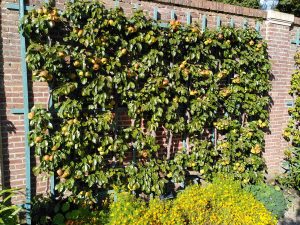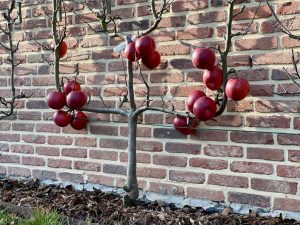World days of the Art of the Espalier
Starting 2025 people can come and celebrate the art of the espalier during the World days of the Art of the Espalier. In several European countries as well as in the United States country houses and estates will open their gardens to the public every first weekend in March (1-2 March 2025) and every third weekend in September (20-21 September 2025), so people can meet and talk to practitioners of the art of the espalier and learn about pruning espaliers.
Art of the espalier
The ‘art of the espalier’ is the art of growing fruit trees trained to orderly two-dimensional forms. Espaliers can be trained against a wall or on a trellis in open ground (‘contre espaliers’). Some well-ordered three-dimensional forms are also called ‘espaliers’.
The art of training fruit trees in espaliers was developed over the centuries by the accumulation of a multitude of small inventions. In the 19th century, the invention of pruning shears and modern wire drawing enabled gardeners to make new and important progress. Today, this art is practiced in many countries all over the world.
The aim of espaliering fruit trees was and is to produce high quality fruit that is both tasty and easily accessible. The result is trees that take up little space on the ground, have a high and regular production potential, a long lifespan and often have an esthetically pleasing shape.
Intangible cultural heritage
Until the middle of the 20th century, the knowledge and know-how of the art of the espalier were the benchmark practice for all fruit-growing activities, used by professionals and amateurs alike. Since then, commercial fruit growing has adopted much less labor-intensive approaches. The art of the espalier has thus entered a transition towards new uses and new practitioners. Today, it is helping to reintroduce fruit trees to the city, where it makes a positive contribution to the environment, biodiversity and individual and collective well-being.
The challenge is to ensure that this ancestral knowledge and savoir-faire is passed on and continues to thrive. Therefore a collective of practitioners of the art of the espalier from a variety of backgrounds and countries are striving to have the art of the espalier recognized as intangible cultural heritage. Since June 2023, the knowledge and skills of the art of espalier have been included in France’s intangible cultural heritage. The collective is now aiming for the UNESCO World Heritage List.
If you have espaliers and want to participate in the World days of the art of the espalier, please contact: lenneke.berkhout@gmail.com or Amisdupotagerduroi@yahoo.fr


